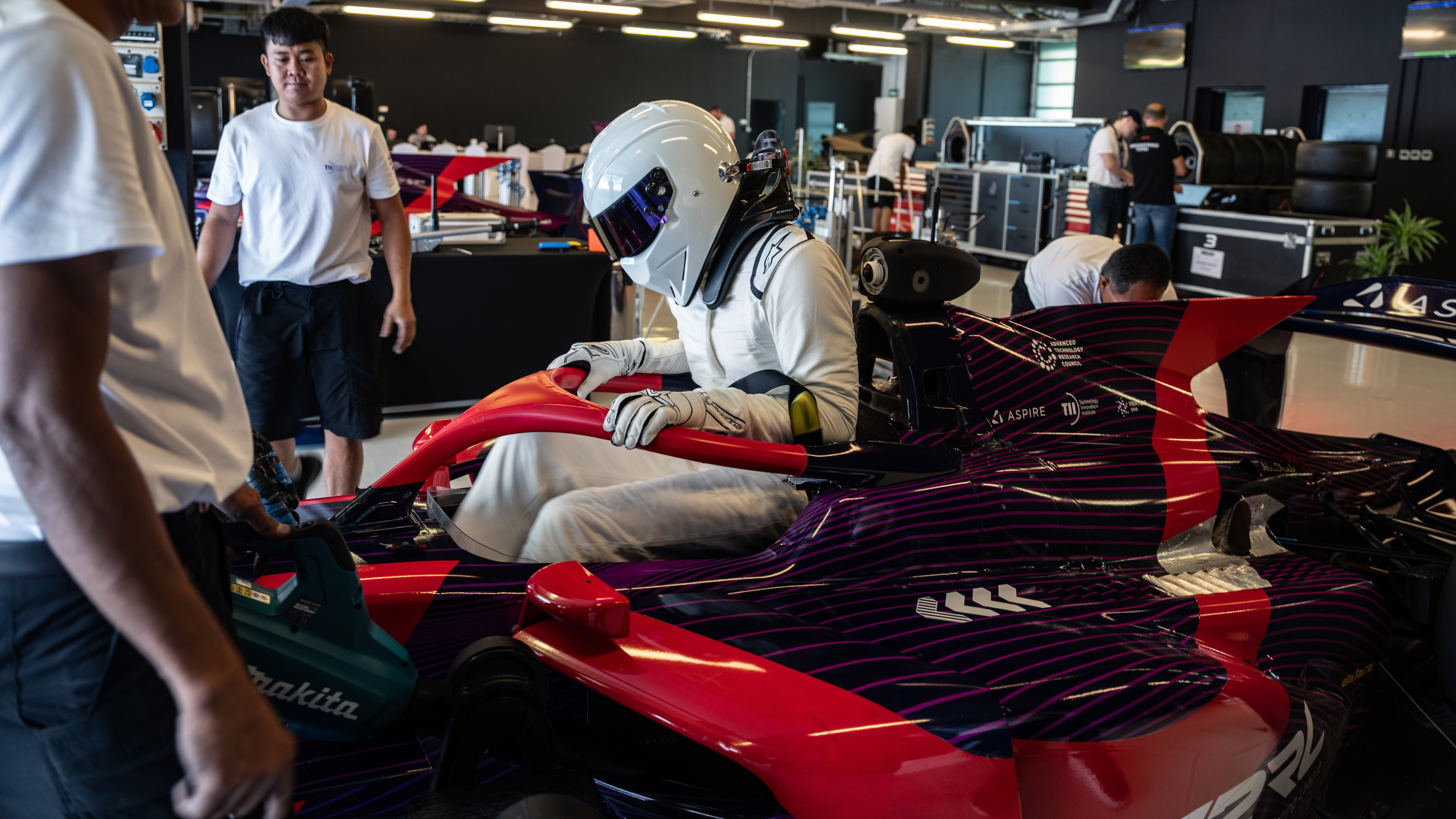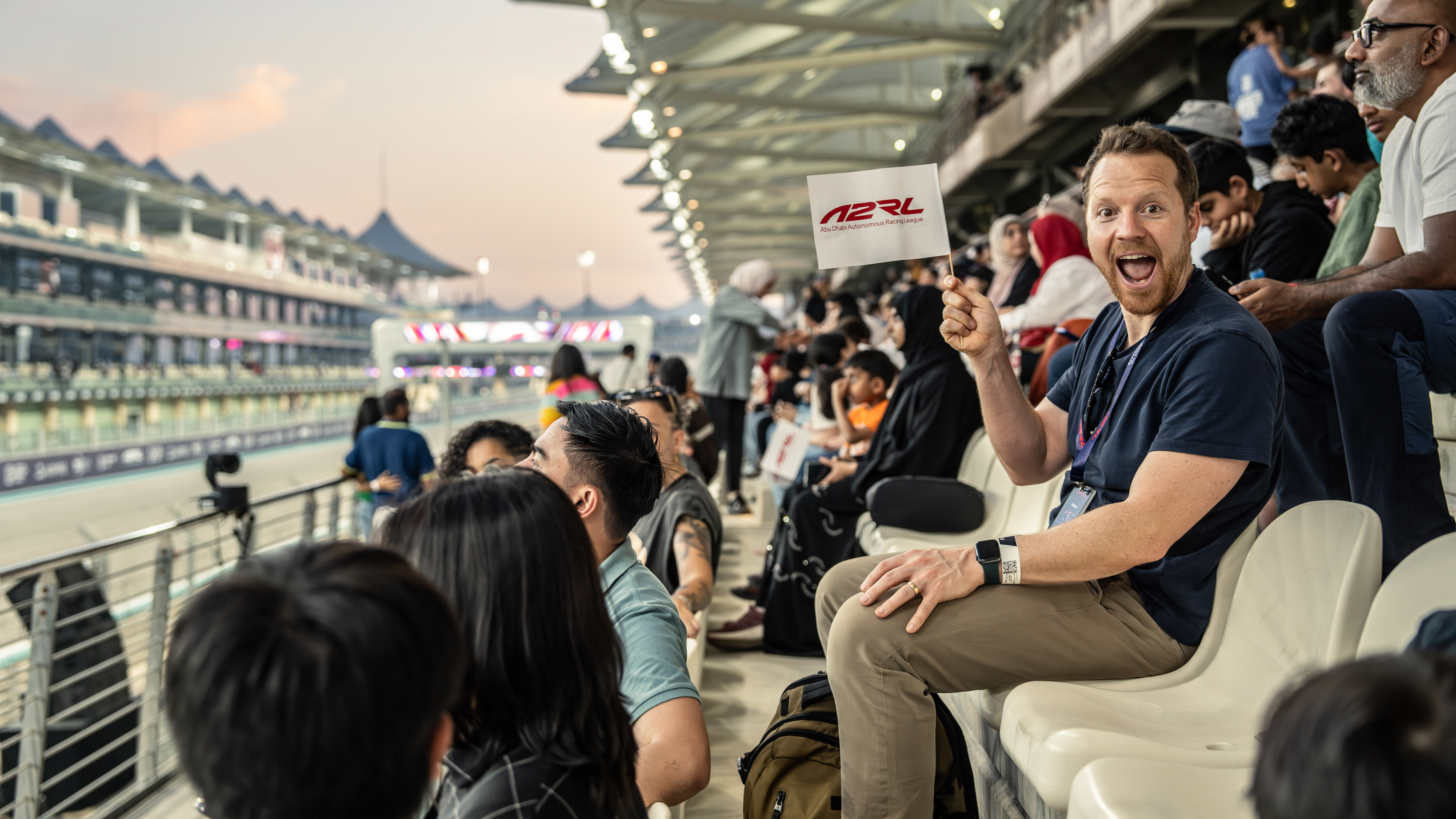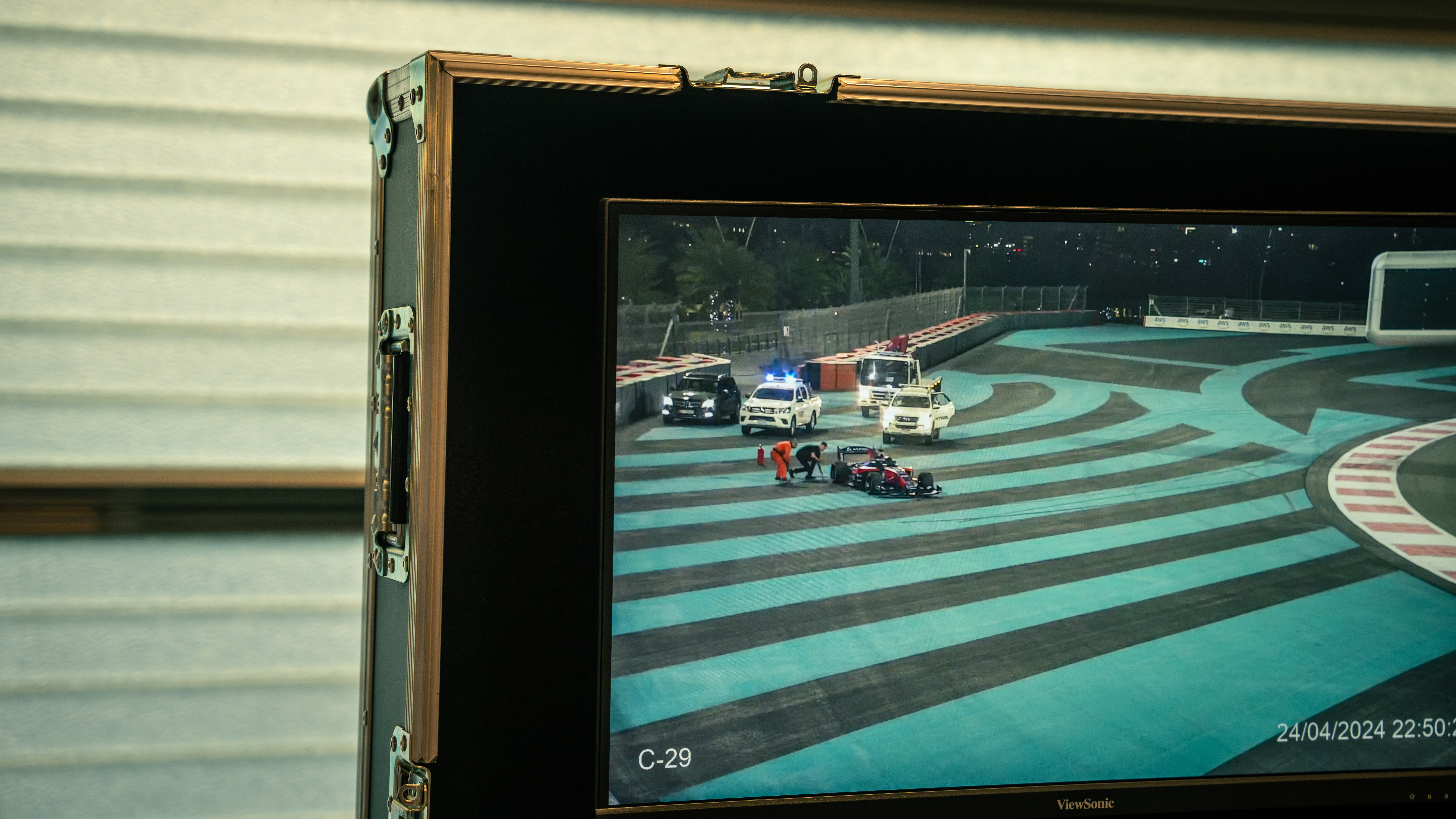
Computer says no: can Stig beat AI in a time trial at Yas Marina circuit?
A2RL is a new Abu Dhabi backed autonomous race series... can AI, er, keep its cool and outsprint Stig?
What do these things have in common: Take That’s new tour, paint drying and autonomous racing? That’s right! They’re the three things I’m least excited about watching in the known universe, and yet I’m sat on the Yas Marina start/finish straight, in Abu Dhabi, along with 10,000 other slightly confused members of the public, cheering on a bunch of racecars fitted with sensors and PCs where humans with otherworldly driving skills and gladiatorial mindsets normally sit. The leader has just spun out on an innocuous left hander, and the other three competitors have ground to a halt, line astern, behind it, unable to fathom going past anything car-shaped under a yellow flag. I’ve seen our autonomous future and it involves very long tailbacks on the motorway.
As a racing spectacle it is an unmitigated disaster. Later, when a team from the Technical University of Munich takes the chequered flag and lion’s share of the $2.25m prize pot (and most of the spectators have wandered off), a 3D drone show and military grade firework display turn a blind eye to this... while reminding everyone of how many hundreds of millions the Abu Dhabi government has spent on this very public science experiment. It’s called A2RL, the Abu Dhabi Autonomous Racing League. And no, we don’t know where the 2 comes from either.
Except, the razzle dazzle of race night is just the glaze on the doughnut. The human effort that’s dragged it to this point and the grand idea going forward is far more compelling. We’ll get to that, but first let’s rewind three days – Stig has miraculously made it through customs and been released from his hardshell travel case, we have the Yas Marina F1 circuit to ourselves... and the chance to conduct a little science experiment of our own.
Photography: Rowan Horncastle
We’re as horrified by the idea of AI taking the place of our beloved racing drivers as you are, convinced the heat of competition can’t be replicated in lines of code, so we’ve hatched a plan to put the computers in their place. A straight-up time trial shootout – Stig versus AI – whichever can set the fastest lap time from a standing start takes the spoils. Both will be driving identical cars – spec Japanese Super Formula racers provided to each of the eight inaugural A2RL teams (rumoured to have cost the organisers $1m per chassis, minus the engine, ouch) – with one crucial difference. One is Stig operated, the other is fitted with all the sensors, radar, cameras and computing power it needs to drive itself, and learn how to go faster while it’s doing it.
A2RL is a coding competition then, brainchild of Aspire, “business development and programme management arm of Abu Dhabi’s Advanced Technology and Research Council”. Essentially, a government arm tasked with diversifying the economy away from the black stuff. “We identify big global technology challenges, things that might take 10 to 15 years to come true, focus on them and try to bring advancement in development in the shorter term,” says exec director Tom McCarthy. Other stuff in the pipeline includes a competition to grow chicken in a lab and autonomous drone racing... we’ll stick with the cars.
With just a few months of simulation and four weeks of testing at Yas Marina, the teams have to ‘teach’ their cars how to process inputs from sensors and produce outputs to the actuators, to not only navigate the track at pace, but react and (with any luck) overtake the cars around them. It’s brain frying stuff. Clearly, part of the appeal is seeing whose AI racecar is going to have the silliest or biggest crash, safe in the knowledge that no humans will be hurt... although the repair bills, currently being footed by the organisers, must smart. Technical director, Giovanni Pau, explains the gulf between the eight teams is significant – four that have AI racing experience and “are flying” and the rest whose tab for new front wings is longer than Hemingway’s bar bill.
The masterstroke here is not defaulting to EVs, which many assumed they would, but going with full fat ICE single seaters that sit just a notch below F1 cars in terms of pace, sound raw and guttural and look fantastic up close. The spectacle of watching self-driving racecars might be a tough sell... but exploding petrol certainly helps.
We wait for the sun to set and the temperature to drop from tyre-melting to merely very sweaty, and it’s Stig up first to set the benchmark. We find him in the basement trying to communicate with the servers, possibly some pre-game trash talk... hard to tell. What we do know is whoever programmed Stig must have uploaded Yas Marina, because he rips off on a few warmup laps before coming to rest on the start line, waiting for lights out and creaming it off into the distance. Totally ignoring the track’s F1-standard timing equipment, I pull out the stopwatch on my phone as Stig navigates Yas’s 5.28km and 16 corners in a mighty impressive 1min 52.52secs. He’s delighted, you can tell by the way he refuses to get out.
Next up is Stig’s AI nemesis. This car belongs to the organisers – it’s the demo vehicle, the fastest they have. Honestly, I have no idea whether it’s about to creep around at 30mph before turning straight into the barrier (yes, this has happened, yes, the video is out there), but it sets off at a decent clip and my word is it bizarre seeing a car move, accelerate, brake and turn with racing purpose... but without a driver. Sure, it could just follow a GPS route when it’s on track alone, but for the car to know when to push, when it has tyre and brake temp, grip and can up the pace, is something exponentially more complicated. All the while it’s also implementing the coder’s overarching strategy – on a scale from cautious to ultra aggressive.
“The soul of the car is the soul of the coder,” Pau explains, poetically. It needs twice the number of warmup laps as Stig but once toasty, it’s tonking round at a serious clip.
A man scuttles to the pit wall with a phone in his hand and a big pause button on the screen. I’m perched up in the starter’s box looking down on him. He taps something to slow the car as it rounds the final corner onto the straight then hits pause to bring it to a stop as near to the start line as possible. He overshoots by 15 metres, no matter, but after settling for five seconds under the gantry, the back end smokes, then glows, then licks into flame. The mechanics grab extinguishers, sprint over and give it a foam bath. One, rather heroically, strips his shirt off and frantically wipes the panels and electronics, aware of how corrosive the gunk can be.
Top Gear
Newsletter
Thank you for subscribing to our newsletter. Look out for your regular round-up of news, reviews and offers in your inbox.
Get all the latest news, reviews and exclusives, direct to your inbox.
Our cameras are rolling the whole time and once the flames are doused we’re half expecting to be escorted into a dark cell, bound and gagged until we hand over the footage, but everyone is entirely pragmatic. This is racing, stuff goes wrong, we learn and move on, it’s all part of the journey. I’m even invited to experience a replay of the fire firsthand on Meta Quest VR goggles that take their feed from an 8K onboard camera, allowing fans with compatible headsets to literally ride along during the race. Over the next 45 minutes the mechanics earn their money – the track is scrubbed and dried, the car stripped, wiped, washed and drenched in WD40 until it looks good as new. The blame is directed to a dodgy fuel line – a rigid metal pipe, that should be a rubber hose, cracked by the intense vibrations.
Meanwhile, a spare £1m+ autonomous racecar is checked over, fired up and sets off on its warmup laps. We’re informed stopping it on the line may have contributed to the inferno, so we change the game: can AI’s flying lap time beat Stig from a standing start? We wait, and wait, as the pace once again builds. We’re asked to park the stopwatch until full chat is achieved... then silence. The car’s avoided the barriers but spun off on the back side of the circuit near the iconic track-straddling W hotel. By now it’s 11.30pm, we only have the place until midnight and with the race event looming this weekend, the A2RL team is reluctant to send it out without knowing what caused the spin. I pull my disappointed face... but have an idea. We find the fastest time from the onboard footage and have our comparison. AI’s best is a 1min 57.0secs – so even with a standing start, Stig is a full 4.5 seconds faster. Of course we timed Stig on a flyer too, because science, and he sets a casual 1min 47.8secs.
Although it has committed to running the series for at least four years, A2RL’s ultimate goal isn’t filling grandstands with adoring fans – which is just as well – but accelerating autonomous tech to improve safety in road cars. Similarly the lab grown chicken challenge is about stepping away from CO2 intensive farming, and learning from the autonomous drone series could be used to speed up organ donor deliveries. It’s noble stuff, and worth remembering when we’re getting sniffy about the race series’ shambolic debut.
But hey, facts are facts, and human(ish) racing drivers can drive a Super Formula car faster around an F1 track than AI can... especially when AI sets itself on fire. Question is, how long until computers rule the racetrack? I’ll give Pau the final word. “So today the development of software technology we have is not yet up to human speed. Stig’s lap time is not yet in danger, but in a year from now... I would be very scared.”











